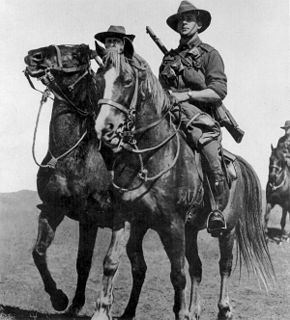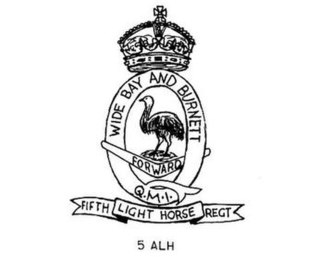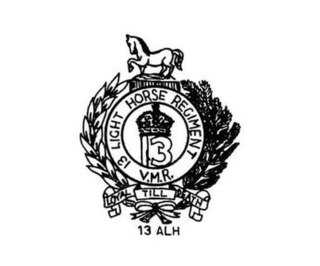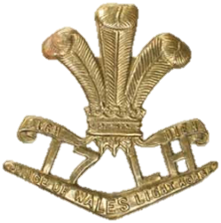
The 1st Royal New South Wales Lancers was an Australian Army light cavalry (reconnaissance) regiment. Its complicated lineage includes the New South Wales Lancers which was first formed as a colonial unit in 1885 as the New South Wales Cavalry, and subsequently saw action in the Second Boer War, and later during First World War at Gallipoli and Palestine as the 1st Light Horse Regiment. The unit subsequently served during the Second World War as the 1st Armoured Regiment equipped with Matilda tanks, fighting the Japanese in New Guinea and Borneo.

The 12th/16th Hunter River Lancers is an Australian Army Reserve cavalry regiment. It was formed on 1 May 1948, although it draws its lineage from units that were originally formed in the 1880s. It is currently a Light Cavalry unit equipped with Bushmaster Protected Mobility Vehicles. The regiment forms part of the 11th Brigade, attached to the 2nd Division and draws its members from regional centres in northern New South Wales, hence the reference to the Hunter River. Since 2000 the regiment has provided individuals as reinforcements to round-out Regular Army units deploying overseas on peacekeeping operations and in the conflicts in Iraq and Afghanistan.

The 1st Light Horse Brigade was a mounted infantry brigade of the Australian Imperial Force (AIF), which served in the Middle Eastern theatre of World War I. The brigade was initially formed as a part-time militia formation in the early 1900s in New South Wales and then later in Queensland. In 1914, the brigade was re-constituted as part of the AIF and was sent to Egypt. Forming part of the New Zealand and Australian Division, during the Gallipoli Campaign it served in a dismounted role between May and December 1915. After being withdrawn to Egypt it served in the Anzac Mounted Division from March 1916 as part of the Egyptian Expeditionary Force, taking part in the Sinai and Palestine Campaign until the end of the war. It was disbanded in 1919. After the war, the AIF light horse regiments were demobilised and disbanded; however, the brigade briefly existed as a part-time militia formation in Queensland until 1921 when its regiments were reorganised into cavalry brigades.

The 2nd Light Horse Brigade was a mounted infantry brigade of the Australian Imperial Force (AIF) which served in the Middle Eastern theatre of World War I. The brigade was initially formed as a part-time militia formation in the early 1900s in New South Wales. In 1914, the brigade was re-constituted as part of the AIF. The brigade first saw action while serving in the Australian and New Zealand Army Corps (ANZAC) during the Gallipoli campaign. After being withdrawn to Egypt in February 1916 they served in the ANZAC Mounted Division from March 1916 as part of the Egyptian Expeditionary Force during the Sinai and Palestine Campaign until the end of the war. After the war, the AIF light horse regiments were demobilised and disbanded; however, the brigade briefly existed as a part-time militia formation in New South Wales until 1921 when its regiments were reorganised into cavalry brigades.

The 5th Light Horse Brigade was a mounted infantry brigade of the First Australian Imperial Force (AIF) that served during World War I. The brigade was initially formed as a part-time militia formation in the early 1900s in Queensland. During World War I, the brigade was formed in Palestine in July 1918 following the disbandment of the Imperial Camel Corps. At this time, the brigade consisted of two Australian Light Horse regiments and a French cavalry regiment, and was supported by British and New Zealand artillery and machine gun troops. It served in the Middle Eastern theatre of World War I in the Sinai and Palestine Campaign as part of the Australian Mounted Division, but only saw limited operations before the war ended, taking part in the capture of Damascus in September and October 1918. After the war, the AIF light horse regiments were demobilised and disbanded; however, the brigade briefly existed as a part-time militia formation in Victoria until 1921 when its regiments were reorganised into cavalry brigades.

The 14th Light Horse Regiment was a mounted infantry or light horse unit of the Australian Army. The unit takes its lineage from units raised as part of the colonial forces of the state of Queensland in 1860 and served during the Second Boer War and World War I. In 1930 it was amalgamated with the 2nd Light Horse Regiment to become the 2nd/14th Light Horse Regiment, a unit that continues to exist as part of the Australian Army today.

The 12th Light Horse Regiment was a mounted unit of the Australian Army. It was raised in New South Wales in 1915 as part of the Australian Imperial Force (AIF) for service during the First World War. After fighting at Gallipoli as reinforcements, the regiment served in the Sinai and Palestine campaign against the Ottoman Empire, seeing action in several notable battles including Beersheba, the capture of Jerusalem, Megiddo and the capture of Damascus. In the aftermath of the war, the regiment was used to suppress the 1919 Egyptian Uprising, before being disbanded in late 1919.

The Battle of Haifa was fought on 23 September 1918 towards the end of the Battle of Sharon which together with the Battle of Nablus formed the set piece Battle of Megiddo fought between 19 and 25 September during the last months of the Sinai and Palestine Campaign of the First World War. During the Battle of Haifa, the Indian 15th Cavalry Brigade, 5th Cavalry Division and part of the Desert Mounted Corps attacked rearguard forces of the Ottoman Empire that resulted in the capture of the towns of Haifa and Acre. This attack took place at the north western edge of the Esdraelon Plain 40–50 miles (64–80 km) behind the front line in the Judean Hills after the Desert Mounted Corps had occupied the plain, during the cavalry phase of the Battle of Sharon.

The 2nd Light Horse Regiment was a mounted infantry regiment of the Australian Army during the First World War. The regiment was raised in September 1914, and by December as part of the 1st Light Horse Brigade had moved overseas. During the war the regiment only fought against the forces of the Ottoman Empire, in Egypt, at Gallipoli, on the Sinai Peninsula, and in Palestine and Jordan. After the armistice the regiment eventually returned to Australia in March 1919. For its role in the war the regiment was awarded nineteen battle honours.

The 3rd Light Horse Regiment was a mounted infantry regiment of the Australian Army during the First World War. The regiment was raised in September 1914, and by December as part of the 1st Light Horse Brigade had moved overseas. The regiment only fought against the forces of the Ottoman Empire, in Egypt, at Gallipoli, on the Sinai Peninsula, and in Palestine and Jordan. After the armistice the regiment eventually returned to Australia in March 1919. For its role in the war the regiment was awarded nineteen battle honours.

The 4th Light Horse Regiment was a mounted infantry regiment of the Australian Army during the First World War. The regiment was raised in August 1914, as the divisional cavalry regiment for the 1st Division. The regiment fought against the forces of the German Empire and the Ottoman Empire, in Egypt, at Gallipoli, on the Western front, on the Sinai Peninsula, and in Palestine and Jordan. After the armistice the regiment eventually returned to Australia in March 1919. For its role in the war the regiment was awarded twenty-one battle honours.

The 5th Light Horse Regiment was a mounted infantry regiment of the Australian Army during the First World War. The regiment was raised in August 1914, and assigned to the 2nd Light Horse Brigade. The regiment fought against the forces of the Ottoman Empire, in Egypt, at Gallipoli, on the Sinai Peninsula, and in Palestine and Jordan. After the armistice the regiment eventually returned to Australia in March 1919. For its role in the war the regiment was awarded sixteen battle honours.

The 6th Light Horse Regiment was a mounted infantry regiment of the Australian Army during the First World War. The regiment was raised in September 1914, and assigned to the 2nd Light Horse Brigade. The regiment fought against the forces of the German Empire and the Ottoman Empire, in Egypt, at Gallipoli, on the Sinai Peninsula, and in Palestine and Jordan. After the armistice the regiment eventually returned to Australia in March 1919. For its role in the war the regiment was awarded sixteen battle honours. During the inter-war years, the regiment was re-raised as a part-time unit based in New South Wales, adopting the designation of the "New South Wales Mounted Rifles". It was later converted to a motor regiment during the early years of the Second World War before being redesignated as an armoured car regiment. Nevertheless, it was disbanded in early 1943 without having been deployed overseas. During the post war years, the regiment was re-raised as part of the Citizens Military Force, and in 1956 was converted into an infantry unit, and in 1960 was subsumed into the Royal New South Wales Regiment.

The 7th Light Horse Regiment was a mounted infantry regiment of the Australian Army during the First World War. The regiment was raised in October 1914, and assigned to the 2nd Light Horse Brigade. The regiment fought against the forces of the Ottoman Empire, in Egypt, at Gallipoli, on the Sinai Peninsula, and in Palestine and Jordan. After the armistice the regiment eventually returned to Australia in March 1919. For its role in the war the regiment was awarded sixteen battle honours. During the inter-war years, the regiment was re-raised as a part-time unit based in New South Wales. It was later converted to a motor regiment during the Second World War but was disbanded in late 1943 without having been deployed overseas.

The 8th Light Horse Regiment was a mounted rifles regiment of the Australian Army during the First World War. The regiment was raised in September 1914, and assigned to the 3rd Light Horse Brigade. The regiment fought against the forces of the Ottoman Empire, in Egypt, at Gallipoli, on the Sinai Peninsula, and in Palestine and Jordan. After the armistice the regiment eventually returned to Australia in March 1919. For its role in the war the regiment was awarded fifteen battle honours. During the inter-war years, the 8th Light Horse was re-raised as a part-time unit based in the Indi region of northern Victoria. It was later converted to a divisional cavalry regiment during the Second World War but was disbanded in 1944 without having been deployed overseas.

The 9th Light Horse Regiment was a mounted rifles regiment of the Australian Army during the First World War. The regiment was raised in October 1914, and assigned to the 3rd Light Horse Brigade. The regiment fought against the forces of the Ottoman Empire, in Egypt, at Gallipoli, on the Sinai Peninsula, and in Palestine and Jordan. After the armistice the regiment eventually returned to Australia in March 1919. For its role in the war the regiment was awarded fifteen battle honours.

The 13th Light Horse Regiment was a mounted infantry regiment of the Australian Army during the First World War. The regiment was raised in March 1915, and eventually assigned as the mounted regiment for the Australian Corps. During the war the regiment fought against the forces of the Ottoman Empire, at Gallipoli, and against the German Empire on the Western Front. For its role in the war the regiment was awarded twelve battle honours. In 1921, it was later re-raised as a part-time unit of the Citizens Forces, and was briefly amalgamated with the 19th Light Horse. During the Second World War, the regiment was converted into an armoured regiment, designated the "13th Armoured Regiment", although it was disbanded in late 1943 without seeing action.

The 11th Light Horse Regiment was a mounted infantry regiment of the Australian Army during the First World War. The regiment was raised in August 1914, and assigned to the 4th Light Horse Brigade. The regiment fought against the forces of the Ottoman Empire, in Egypt, at Gallipoli, on the Sinai Peninsula, and in Palestine and Jordan. After the armistice the regiment eventually returned to Australia in March 1919. For its role in the war the regiment was awarded fourteen battle honours. During the inter-war years, the regiment was re-raised as a part-time unit based in the Darling Downs region of Queensland. It was later converted to a motor regiment during the Second World War but was disbanded in 1943 without having been deployed overseas.

The Charge at Irbid occurred on 26 September 1918 as a consequence of the victory at the Battle of Megiddo during the subsequent inland pursuit by Desert Mounted Corps to capture Damascus in the Sinai and Palestine Campaign of World War I. The charge occurred when the 2nd Lancers of the 10th Cavalry Brigade, 4th Cavalry Division, attacked the Ottoman Army garrison defending the town of Irbid.

The 17th Light Horse Regiment was a Citizens Military Force (CMF) unit of the Australian Light Horse, formed during the 1912 reorganisation of the Australian Army. The regiment traces its origins back to the militia cavalry regiments raised in the colony of Victoria, such as the Royal Volunteer Cavalry Regiment, the Prince of Wales's Light Horse Hussars and the Sandhurst Cavalry Troop.






















